Ramayana Parampara in North-East India: Tripura
- In History & Culture
- 12:03 PM, May 05, 2023
- Ankita Dutta
This is the third part of the series of articles on the Ramayana tradition in North-East India. Earlier, the different traditions of the Ramayana prevalent in Assam and in Meghalaya among the Khasis, Garos, and Jaintias were covered. The next state that has been taken up in this series is Tripura, nestled along the borders of Assam, Bangladesh, and Mizoram. The article shall first briefly cover the Hindu cultural history and heritage of Tripura, before moving on to the tradition of the Ramayana that is prevalent among different communities of the state.
One of the oldest princely states in the country until recent history, Tripura is home to several vanavasi communities such as Jamatiyas, Chakmas, Hajongs, Reangs, etc. who account for a significant percentage of its total population. Tripura is a combination of tri, meaning three; and, pura meaning city in Sanskrit; hence Tri-pura or three cities. It is believed that the word tri represents Shiva who is believed to have destroyed three cities of Asuras who ruled in this region. In the local Kokborok language of Tripura which is the main language of the Debbarmas, it is also known as Tuipra – Tui implies a water body and Pra means mouth.
Thus, Tuipra means the mouth of a river. The geographical location of the state with its close proximity to the vast water resources of Eastern Bengal (present-day Bangladesh) coupled with the identity of the state’s original inhabitants as Tipra or Twipra, apparently justifies this explanation of the name of the state. In a few historical texts, the name of this region has also been mentioned as Kirata Desa. In both the Yajurveda and the Atharva Veda, the Kiratas have been referred to as a group/community of people who live in hilly and mountainous areas and are endowed with unique fighting skills.
Tripura has had an inseparable cultural association with Bharatvarsha since the Vedic period. The Mahabharata mentions a kingdom in the extreme North-East of Bharat which was ruled by a king named Tripur. It was Tripur who eventually decided to collectively rule the state named Tripura along with Raja Yudhisthira. It is believed that this is how the present-day state of Tripura state got its name. At the peak of its glory, the geographical realm of the princely state of Tripura extended till modern-day Myanmar in the east to the Sunderbans in the south, and the Brahmaputra basin in the north-west.
There have been two very significant periods in the history of Tripura, both of which have been detailed in the ancient Bengali poem titled Rajamala. It narrates the extensive lineage of the 144 Maharajas of Tripura in carefully crafted verses that were put together by learned Brahmins in the court of the famous king Dharma Manikya who was also known among the local people as Dangar Fa. This unbroken lineage was established by its founder, a chief named Maha Manikya, in the early 1400s. Maha Manikya took over control of Tripura and its neighbouring communities before assuming the title Manikya to celebrate his victory over Bengal.
This was followed by a genealogy of 185 rulers who had achieved remarkable success through their military conquests and the overall expansion of the kingdom. Just like the history of Pragjyotispur would remain incomplete without any reference to the Kamakhya Saktipeeth, similarly, the history of Tripura too would be incomplete without a mention of Ma Tripura Sundari’s Abode in Udaipur, around 55 kms from the capital city of Agartala. Devi Tripurasundari is one of the deities of the Dásá Máhávidyas. Also worshipped as the ságuna-roopa of Adi Parasákti, She represents the feminine aspect of Param Brahman.
Devi Tripurasundari is hailed as a great unifier among the followers of the Sakta-Tantric panth of Hindu Dharma. Along with Sada-Siva (or Tripuratanka), Devi Tripurasundari is responsible for the Pancha-Krityas – sristi or creation, sthithi or protection, samhara or destruction, thirodhana or concealment of the world in maya, and anugraha or final liberation. Devi Tripurasundari is worshipped in many temples across India, but the most noteworthy place of Her worship is the Tripura Sundari Mandir of Tripura. For those who might not be aware, the Tripura Sundari Mandir is one of the 52 Sakti Peethas of Bharat.
It was Sati’s right leg that had fallen in the spot where this temple is located at present. Ma Tripura Sundari is worshipped by all people of Tripura, from the Twipras (Debbarmas, Reangs, Jamatias, Murasings) who are the original inhabitants of Tripura, the Hindu Bengalis, and as well as the Tripura royal family. According to the Brahmanda Purana, Visnu became the elder brother of Parvati in Her swaroop as Ma Tripura Sundari and helped her to be the consort of Siva. Hence, perhaps because of this reason, along with Ma Tripura Sundari/Tripuresvári at the Tripura Sundari temple, Visnu is also worshipped in the form of a saligrama.
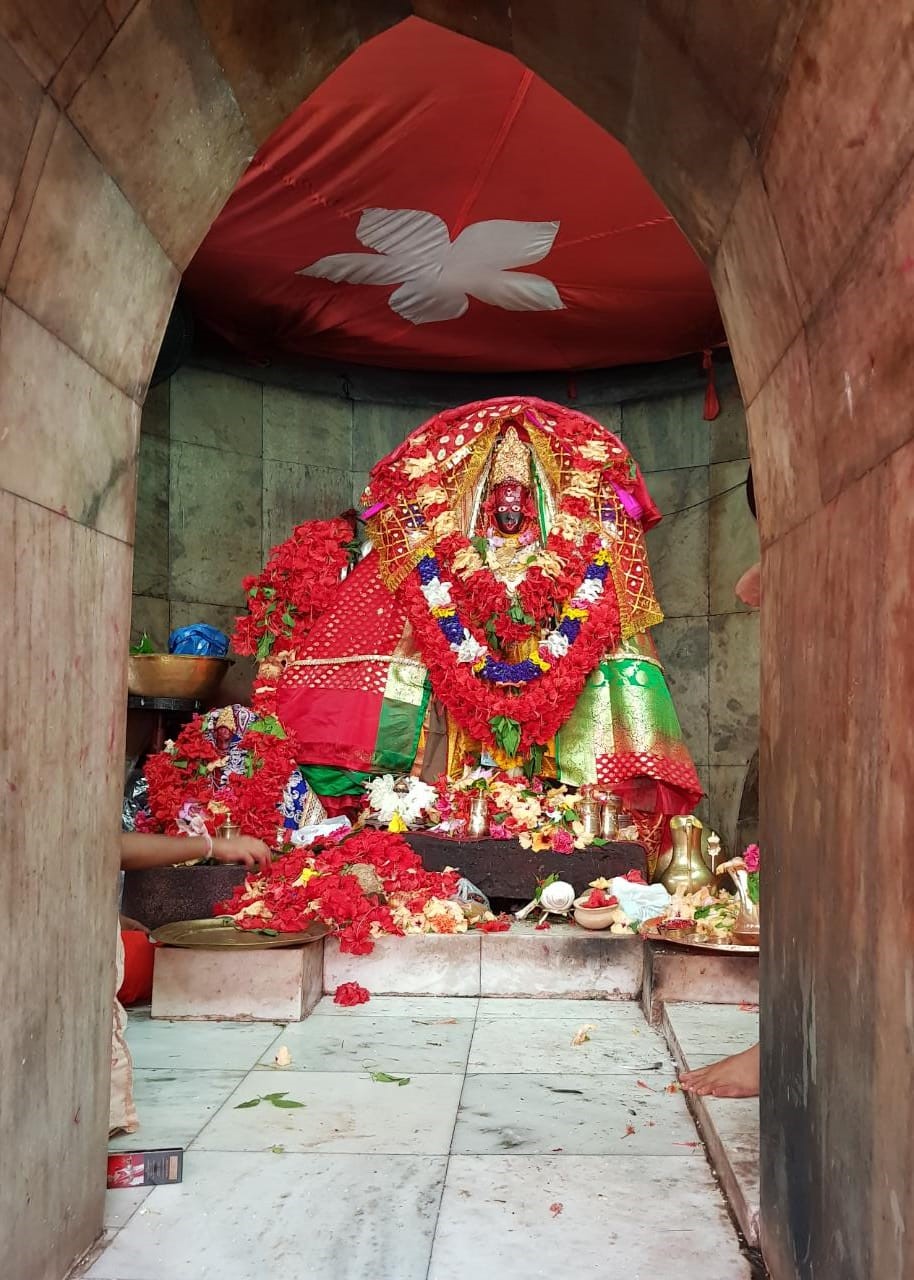
Devi Tripurasundari at Her Abode in Udaipur, Tripura
The Tripura Sundari temple is built atop a hillock, which is in the shape of the back of a tortoise (understood as kurma avatar in Hindu Dharma). In Sákta parampara, this is believed to be one of the most sacred sites for a Saktipeeth to be located. According to a story associated with the temple and as written in the Rajamala, Raja Dhanya Manikya who ruled over Tripura towards the latter part of the 15th century, had a revelation one night in a dream in which Ma Tripura Sundari instructed him to shift Her murti from Chittagong (in present-day Bangladesh) and initiate Her worship on the hillock near Udaipur, the then capital of the kingdom.
The king found out that a temple on the hillock was already dedicated to Visnu. He was in a dilemma, unable to decide how a temple dedicated to Visnu could have a murti of Sakti. The following night, the divine vision was repeated again, with Ma Tripura Sundari coming along with Brahma, Visnu and Máheswara. It was then that the king finally understood that Visnu and Sákti were different swaroops of the same Brahman. Thus, the temple of Ma Tripura Sundari in present-day Agartala came into being. It is the place of convergence of Vaisnava and Sakta followers of Tripura.
There is another temple – the Chaturadasa temple (Chaturadasa literally meaning ‘the temple of 14 deities’) – which is a popular Hindu religious place of worship in Tripura, where 14 Kokborok deities (important deities of the Tripura royal family) are worshipped. These deities include – Brahma, Visnu, Siva, Durga, Laksmi, Kartikeya, Saraswati, Ganesa Samudra, Prithvi, Agni, Ganga, Himadri, and Kamadeva. They are known by the local names of Burasa, Lampra, Bikhatra, Akhatra, Thumnairok, Sángroma, Bonirok, Twima, Songram, Mwtaikotor, Mailuma, Noksumwtai, Swkalmwtai, and Khuluma respectively.
The historical belief is that the mother of Raja Trilochan who was the king of Tripura, had saved these 14 deities from being killed by a wild buffalo when she had gone to take a bath in the nearby Maharani River. The deities eventually killed the beast with her help. Happy with the efforts of the king’s mother, the 14 Kokborok deities visited King Trilochan's palace in Udaipur. The royal family offered Puja to the fourteen deities and also sacrificed wild buffaloes. Kharchi Puja is a century-old, important Hindu religious festival celebrated at this temple.
A beautiful amalgamation of Vedic Hindu and local Kokborok customs, Kharchi Puja is celebrated annually during the month of Aashad (June-July). It takes place 15 days after the end of the Ambubachi celebrations at the Kámákhya Saktipeeth, and is believed to be a way of purifying Bhúdevi after Ambubachi. This immensely rich cultural history and heritage of Tripura certainly brings forth the point that both the Ramayana and the Mahabharata had always been an integral and inseparable part of this heritage. Prof. Prabhas Chandra Dhar first translated the original Valmiki Ramayana into the Kokborok language in the 20th century.
Prof. Dhar’s rendition of the Valmiki Ramayana in Kokborok was deeply influenced by the Krittivasi Ramayana composed in the 16th century by the famous Bengali poet Krittivas Ojha. As mentioned in the earlier articles in this series, the story of Shri Ram has played a profound role in the life and culture of the people of the Northeast. Since the first elaborate rendition of the character of Ram by Madhav Kandali in his Assamese version of the Valmiki Ramayana, the epic has been retold in countless ways through various media, adapting to the values and ethos of the diverse vanavasi cultures that make up the North-East.
These renditions are all connected to one another by their adherence to the eternal spiritual and philosophical values enshrined in the story of the Ramayana. The diverse manifestations of the story of Ram in the many different versions of the Ramayana prevalent in the Northeast are a beautiful reflection of the quintessential spirit of the cultural unity of Bharatvarsha. Unfortunately, many aspects of the Ramkatha tradition in the Northeast, particularly the oral traditions of smaller communities such as Hmars, Chakmas, Reangs, and Hajongs, have remained a largely neglected area of research.
Mainly because of the strategic and geographical location of the North-East at the major immigration routes from South-East Asia, the South-East Asian versions of the story of the Ramayana have been influenced by the different narratives of Shri Ram that were or are still popular in a few regions of the North-East. Thus, the distinctive cultural values and ethos of the North-Eastern region of the country and its contact with different cultures of South-East Asia throws significant light on the Hindu history and the society and culture of this region, specifically with respect to the varied expressions of the Ramayana that are prevalent here.
In Tripura, the Ramayana and the story of Shri Ram, Lakshman, Sita, Hanuman, and Ravana have tremendously influenced the life and culture of the people in varied ways. The region shows acquaintance with the Ramkatha tradition since ancient times. In the Rajaratnakara – an important historical text of Tripura composed in the 15th century – we come across several references to Puru Sen, an early king of Tripura, as a contemporary of Raja Dasharatha of Ayodhya. It is also mentioned that Puru Sen had gone to Ayodhya for attending an agni homa ceremony performed by Raja Dasharatha.
This is mentioned in Part I 9th Sargha of the Sri Sri Rajaratnakara. Leaving aside the veracity of these historical claims as they have been questioned by a few historians of the later period, it certainly indicates a fair-enough acquaintance of the people of present-day Tripura with the Ramayana. In the first half of the 19th century, author Shivendra Dwija, under the patronage of Raja Ramaganga Manikya of Tripura, composed a version of the Adhyatma Ramayana in Sanskrit. At the initiative of Raja Ramaganga, who was an ardent devotee of Sri Ram, the text was published and preached among the subjects of his kingdom.
This is mentioned in an article titled ‘The Tradition of the Ramayana and Tripura: The Ramayana in North-East India’ written by Sitanath Dey. It may also be mentioned here that the Bengali rendition of the Ramayana by Krittivas is immensely popular among the people from the interior hills to the plains of Tripura. It is from the Ramayana that various works of literature including poems, plays, songs and paintings, and dramatic traditions based on the story of Ram and Sita have emerged in the cultural and literary heritage of the state.
A performing art form of Tripura called Ram Panchali is based on different stories from the Ramayana. A very raw and simple form of local poetical tradition based on the Ramayana, it is performed on different occasions, particularly during Shradh ceremonies, and this tradition still exists in a few remote villages of Tripura. Ramayan Pala Kirtan is another Ramkatha-based performing art tradition of Tripura comprising song, dance and drama, with various elements of Vaishnavism, especially Naam-Kirtan being infused into it. It is generally performed at night during the winter season after the cycle of crop harvesting comes to an end.
Presented in the form of a song by talented musicians and singers especially trained for the purpose, the Ramayana Pala Kirtan requires around 4-5 nights to complete the entire story. There is a rich tradition of dance and drama based on the story of the Ramayana among several tea garden communities of Tripura too, such as the Santhals, Mundas, Tantis, Nunisa, and Gauds, which is especially performed during festivals like Holi and Tusu Puja. Another important dance drama tradition of Tripura based on different themes from the Ramkatha is known as Kathamos.
Kathamos is staged by professional musical and dance troupes during the annual festival of Charak Puja which is held in honour of Shiva. Kathamos is characterized by traditional songs and music, beautiful foot works, and elaborate limb movements, besides the usage of masks and specific costumes based on the enactment of the different characters. Episodes from the Ramayana that are usually selected for the performance of Kathamos include the marriage ceremony of Ram and Sita, Ram’s vanavas, Sita’s abduction by Ravana, the war between Ram and Ravan, the birth of Luv and Kush, etc.
The story of Shri Ram has had a profound influence on the oral traditional heritage of Tripura as well. The different episodes and characters of Ramkatha are a part of the daily lives of the people here. They have found a way into many of their proverbs, riddles, music and art, marriage songs, religious beliefs, festivals, etc. For example, the famous Dhamail and Saotali songs of Tripura are inspired by different themes from the Ramayana. The importance of Ram in the lives of the people of Tripura is also evident from the association of the names of people, places, hills and mountains, flora and fauna etc. with different characters from the Ramayana.
Its influence is also aptly evident in different traditional games and sports popular in different regions of Tripura. In a few southern districts of Tripura, there is a local game prevalent among a few vanavasi communities, comprising a short song along with a few physical demonstrations. These demonstrations depict martial warfare based on the story of Ram, Lakshman, and Hanuman on the eve of their war with Ravan in Lanka. Jagadish Gyan Choudhury has written elaborately on this and several other important aspects of the Tripuri Ramayana.
It is also believed that the famous Ashokastami festival celebrated in Tripura annually during March-April is closely connected with the Ramayana. The belief is that Shri Ram, before embarking on his journey to defeat Ravan, had performed the Ashokastami Puja at the same spot in Tripura where the pilgrims gather today. Some of the main rituals of the festival are the worship of Shiva and Shakti and taking a dip at the sacred reservoir known as the Ashtamikunda or Sitakunda. It is considered to be extremely pious, as it brings good fortune, success, and all-round prosperity to families.
The Ashtamikunda or Sitakunda is a natural body of water in Tripura that remains at the heart of all Hindu religious traditions of the state. The story of the Ramayana has also found expression in several architectural and archaeological marvels of the state such as the ruins at Unakoti and as well as those at Pilak. Unakoti is famous for the massive rock-cut carvings of Shiva. Apart from its religious significance, Unakoti is an important archaeological site too. With intricate carvings on stone and various other sculptures associated with Hindu Dharma, this is a very important place, both from the historical-archaeological and religious points of view.
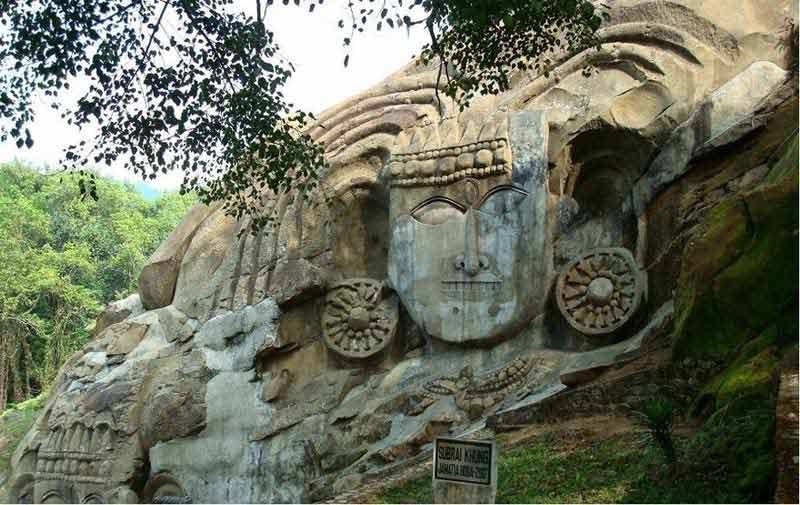
Rock Carvings at Unakoti
Another place in Tripura called Pilak, is a well‐known Buddhist site famous for well-moulded terracotta plaques (dated roughly to the 9th-10th centuries A.D.) of Buddhist divinities and Hindu Devis and Devatas. Several such images can be seen in the outer walls of the Shyamsundar Tilla temple at Pilak. In the terracotta plaques of Pilak, there are numerous images of Shri Ram holding the bow for killing Bali, Mata Shakti in different forms, the head of Shiva, Nandi, Narasimha, Buddha, Vajra, Tara, etc. Brahma, Vishnu, Kamadev, Ram, Laxman, Narasimha, and Hanuman have been depicted in their usual religious forms.
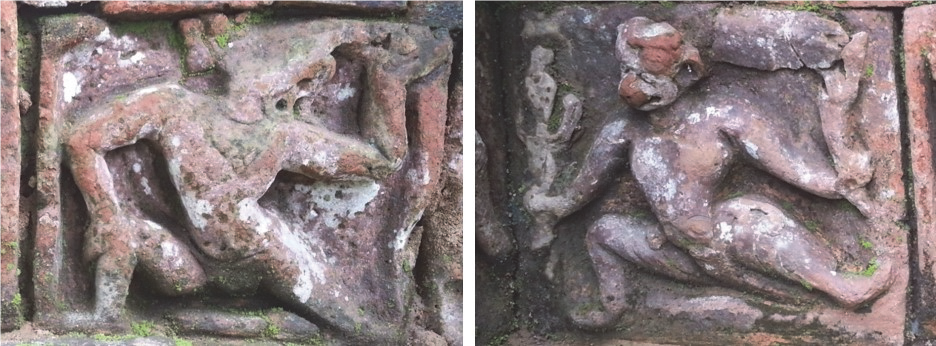
Depiction of Varaha and Hanuman at Pilak, Tripura
In these plaques, the figures of both Ram and Laxman in a seated posture are the most prominent among all. Ram can be seen holding the bow in His left arm in the Abhaya mudra pose. Interestingly, the figures are in different sizes and Ram appears larger than Laxman. The famous golden deer as described in the Ramayana has also been beautifully depicted in one of the plaques where the deer is shown to be running and being targeted by Ram with His bow. Hanuman has been depicted in the position crossing the ocean. At the bottom, fishes and crocodiles have been depicted with the effect of waves in a zig‐zag fashion.
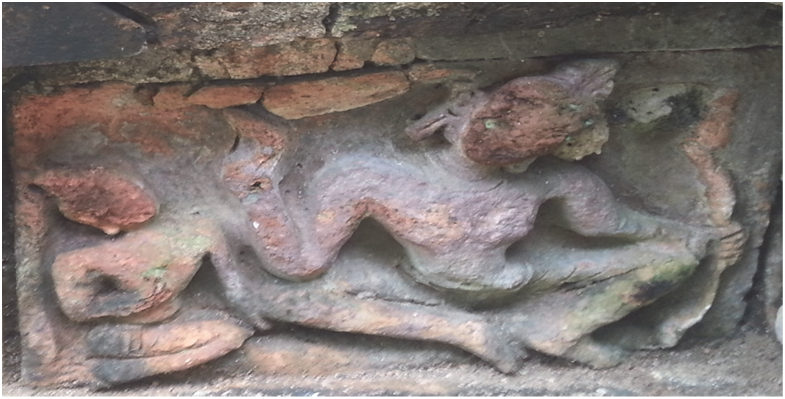
Depiction of Ram and Lakshman in one of the terracotta plaques at Pilak
Popular animal images like buffalo, deer, lion, rhino, tiger, pigs and milking calves have also been depicted in these plaques. All these are proof enough of the fact that the Ramkatha tradition is widely prevalent in the literary, performing arts, and oral cultural heritage of Tripura. Thus, just like in any other part of Bharat where the religious and spiritual dimensions of the Ramkatha find a foremost place in the collective consciousness of the people, the character of Ram as an epitome of ultimate human virtues, values and ideals is embedded in the story is a part of the collective cultural consciousness of the people in the North-East too.
References:
- Sri Rajaratnakara, Part I, 9th Sargh, pp.86-90.
- Bhattacharjee, P. (2012). Temple Architecture of Princely Tripura. Agartala: Nabachandana Prakashani.
- Choudhury, Jagadish Gyan. (1998). Tripuri Ramayana, Ramayana in North-East India. Gauhati University.
- Das, R. (1987). Art and Architecture of Tripura. Agartala: Tribal Research Institute, Govt. of Tripura.
- Dey, Sitanath. (2005). A Reflection To Our Cultural Heritage Through Sanskrit Studies. Sanskrit Pustak Bhandar.
- Poddar, Satyadeo. (ed.) History of Tripura: As Reflected in the Manuscripts. National Mission for Manuscripts, Indira Gandhi National Centre for the Arts, 2016.
(The photos in the article are from the author’s personal collection)
Cover image courtesy: The Indian Express



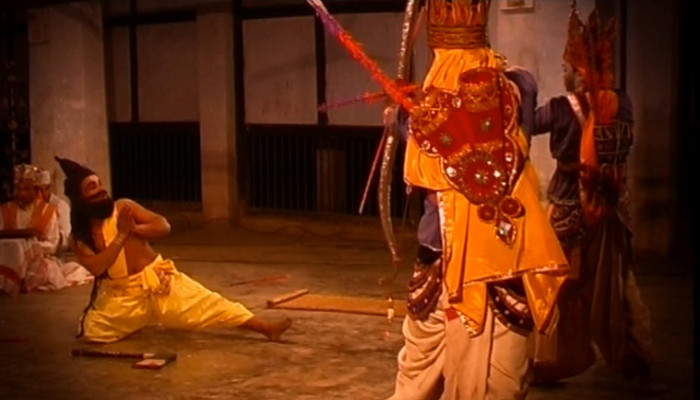
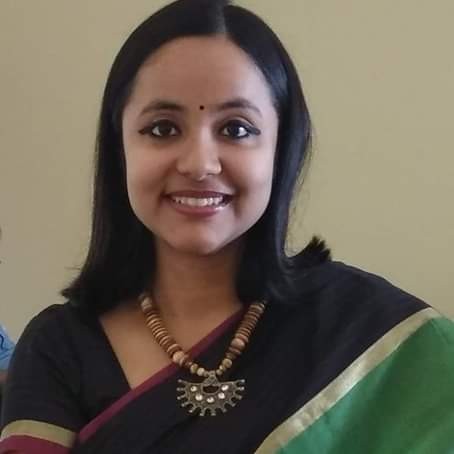


Comments